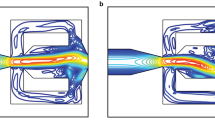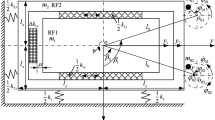Abstract
The stability and synchronous rotation of oscillators is a key technology of the sonic drilling rigs, vibratory breakers and pile sinkers. This paper studies the stability and synchronization properties of two oscillators in a solid–liquid coupling system. The system mainly comprises two oscillators, two hydraulic motors and a gear pair. Since each oscillator is driven by a hydraulic motor and the hydraulic motors are connected in parallel, a new dynamic model of the two oscillators is established. In this model, we consider both the nonlinearity of the gear pair and the hydraulic factors. According to the numerical results, the new method improves the stability of the system. The rotational angle and speed deviations indicate that the system can guarantee the synchronization of the two oscillators when the meshing stiffness and meshing damping ratio of the gear system are varied. The synchronization accuracy is excellent. Additionally, the numerical results are validated by simulation in AMESIM software.












Similar content being viewed by others
Availability of data and material
All data generated or analyzed during this study are included in this published article.
Abbreviations
- Q Tin :
-
Inlet volume flux of the system.
- Q Tout :
-
Outlet volume flux of the system.
- Q ti :
-
Load volume flux of the hydraulic motor (HM) i, i = 1,2. (the same below)
- Q in ti :
-
Inlet volume flux of the HM i.
- Q out ti :
-
Outlet volume flux of the HM i.
- p t :
-
Inlet pressure of the system.
- p Li :
-
Load pressure of the HM i.
- p in i :
-
Inlet pressure of the HM i.
- p out i :
-
Outlet pressure of the HM i.
- C tmi :
-
Internal leakage coefficient of the HM i.
- J mi :
-
Rotational inertia of the HM i.
- J oi :
-
Rotational inertia of the oscillator i.
- J gi :
-
Rotational inertia of the gear i.
- B mi :
-
Rotational damping coefficient of the HM i.
- B oi :
-
Rotational damping coefficient of the oscillator i.
- B gi :
-
Rotational damping coefficient of the gear i.
- K vi :
-
Torsional stiffness of the connector i.
- θ mi :
-
Rotational angle of the HM i.
- θ oi :
-
Rotational angle of the oscillator i.
- θ gi :
-
Rotational angle of the gear i.
- ω mi :
-
Rotational speed of the HM i.
- ω oi :
-
Rotational speed of the oscillator i.
- ω gi :
-
Rotational speed of the gear i.
- ω h :
-
Meshing speed of the gear pair.
- φ 0 :
-
Initial phase error of the gear pair.
- e g :
-
Comprehensive transmission error
- C g :
-
Meshing damping
- K g :
-
Meshing stiffness
- b c :
-
Backlash
References
Balthazar, J.M., Felix, J.L.P., Brasil, R.: Short comments on self-synchronization of two non-ideal sources supported by a flexible portal frame structure. J. Vib. Control 10, 1739–1748 (2004). https://doi.org/10.1177/1077546304041754
Balthazar, J.M., Felix, J.L.P., Brasil, R.M.: Some comments on the numerical simulation of self-synchronization of four non-ideal exciters. Appl. Math. Comput. 164, 615–625 (2005). https://doi.org/10.1016/j.amc.2004.06.010
Bergada, J.M., Watton, J., Kumar, S.: Pressure, flow, force, and torque between the barrel and port plate in an axial piston pump. J. Dyn. Syst. Meas. Control-Trans. ASME. 130, 011011 (2008). https://doi.org/10.1115/1.2807183
Blekhman, I.I., Fradkov, A.L., Nijmeijer, H., Pogromsky, A.Y.: On self-synchronization and controlled synchronization. Syst. Control Lett. 31, 299–305 (1997). https://doi.org/10.1016/S0167-6911(97)00047-9
Cao, Z., et al.: Effects of the gear eccentricities on the dynamic performance of a planetary gear set. Nonlinear Dyn. 91, 1–15 (2018). https://doi.org/10.1007/s11071-017-3738-0
Chang, J., Wan, C.: Strong nonlinearity analysis for gear-bearing system under nonlinear suspension—Bifurcation and chaos. Nonlinear Anal.-Real World Appl. 11, 1760–1774 (2010a). https://doi.org/10.1016/j.nonrwa.2009.03.027
Chang, J., Wan, C.: Nonlinear analysis for gear pair system supported by long journal bearings under nonlinear suspension. Mech. Mach. Theory. 45, 569–583 (2010b). https://doi.org/10.1016/j.mechmachtheory.2009.11.001
Chen, Y.-C., Yang, T.-H., Choi, S.-T.: Dynamic analysis of a double-helical geared rotor system with oil-film bearing. AEAT. 92, 653–662 (2020). https://doi.org/10.1108/AEAT-05-2019-0094
Chen, Z., et al.: Dynamic investigation of a locomotive with effect of gear transmissions under tractive conditions. J. Sound Vibr. 408, 220–233 (2017). https://doi.org/10.1016/j.jsv.2017.07.017
Farshidianfar, A., Saghafi, A.: Global bifurcation and chaos analysis in nonlinear vibration of spur gear systems. Nonlinear Dyn. 75, 783–806 (2014). https://doi.org/10.1007/s11071-013-1104-4
Han, Q., et al.: Dynamic analysis of a geared rotor system considering a slant crack on the shaft. J. Sound Vibr. 331, 5803–5823 (2012). https://doi.org/10.1016/j.jsv.2012.07.037
K Khoozani, M., Poursina, M., P Anaraki, A.: Study of gyroscopic effects on the dynamics and vibrations of double-helical planetary gear set. In: Proceedings of the IMechE. 146441931772594 (2017). https://doi.org/10.1177/1464419317725947
Kahraman, A., Singh, R.: Non-linear dynamics of a spur gear pair. J. Sound Vibr. 142, 49–75 (1990). https://doi.org/10.1016/0022-460X(90)90582-K
Kang, M.R., Kahraman, A.: An experimental and theoretical study of the dynamic behavior of double-helical gear sets. J. Sound Vibr. 350, 11–29 (2015). https://doi.org/10.1016/j.jsv.2015.04.008
Li, L., Chen, X.: Times-frequency synchronization of two exciters with the opposite rotating directions in a vibration system. J. Sound Vibr. 443, 591–604 (2019). https://doi.org/10.1016/j.jsv.2018.11.046
Li, M., Hu, H.Y.: Dynamic analysis of a spiral bevel-geared rotor-bearing system. J. Sound Vib. 259, 605–624 (2003). https://doi.org/10.1006/jsvi.2002.5111
Li, M., Hu, H.Y., Jiang, P.L., Yu, L.: Coupled axial–lateral–torsional dynamics of a rotor–bearing system geared by spur bevel gears. J. Sound Vib. 254, 427–446 (2002). https://doi.org/10.1006/jsvi.2001.4016
Li, Y., et al.: Influence of asymmetric mesh stiffness on dynamics of spiral bevel gear transmission system. Math. Probl. Eng. 2010, 1–13 (2010). https://doi.org/10.1155/2010/124148
Li, Y., et al.: Non-linear dynamics of gear pair with dynamic backlash subjected to combined internal and external periodic excitations. J. Vib. Control. 22, 1693–1703 (2016). https://doi.org/10.1177/1077546314544350
Liu, L., Wang, Y., Qian, Y., Li, S.: Dynamic analysis of sonic vibration drilling string with the sampling tool. Alex. Eng. J. 61, 8703–8713 (2022). https://doi.org/10.1016/j.aej.2022.02.012
Luo, C.L., Mo, X., Li, J.Y., Tang, Z.Q., Huang, S.S.: Coupling synchronization criterion of two hydraulic motors in an eccentric rotary vibration machine. Shock Vib. 2019, 1–11 (2019). https://doi.org/10.1155/2019/6086874
Nevzat Özgüven, H., Houser, D.R.: Mathematical models used in gear dynamics—A review. J. Sound Vibr. 121, 383–411 (1988). https://doi.org/10.1016/S0022-460X(88)80365-1
Pahnehkolaei, S.M.A., Alfi, A., Machado, A.T.: Fuzzy logic embedding of fractional order sliding mode and state feedback controllers for synchronization of uncertain fractional chaotic systems. Comput. Appl. Math. 39, 182 (2020). https://doi.org/10.1007/s40314-020-01206-7
Parker, R.G., et al.: Non-linear dynamic response of a spur gear pair: modelling and experimental comparisons. J. Sound Vibr. 237, 435–455 (2000). https://doi.org/10.1006/jsvi.2000.3067
Perlikowski, P., Stefański, A., Kapitaniak, T.: 1:1 Mode locking and generalized synchronization in mechanical oscillators. J. Sound Vibr. 318, 329–340 (2008). https://doi.org/10.1016/j.jsv.2008.04.021
dos Santos, L.O.E., Philippi, P.C., Bertoli, S.L., Facin, P.C.: Lattice-gas models for single and two-phase flows: application to the up-scaling problem in porous microstructures. Comput. Appl. Math. 21, 545–571 (2002)
Shin, D., Palazzolo, A.: Nonlinear analysis of a geared rotor system supported by fluid film journal bearings. J. Sound Vibr. 475, 115269 (2020). https://doi.org/10.1016/j.jsv.2020.115269
Velex, P., Flamand, L.: Dynamic response of planetary trains to mesh parametric excitations. J. Mech. Des. 118, 7–14 (1996). https://doi.org/10.1115/1.2826860
Wang, C., Wang, S.R., Yang, B., Wang, G.Q.: Dynamic modeling of double helical gears. J. Vibrat. Control. 24, 3989–3999 (2018). https://doi.org/10.1177/1077546317717885
Yavuz, S.D., et al.: Nonlinear dynamic analysis of a drivetrain composed of spur, helical and spiral bevel gears. Nonlinear Dyn. 100, 3145–3170 (2020). https://doi.org/10.1007/s11071-020-05666-8
Yavuz, S.D., et al.: Nonlinear time-varying dynamic analysis of a spiral bevel geared system. Nonlinear Dyn. 92, 1901–1919 (2018). https://doi.org/10.1007/s11071-018-4170-9
Zhang, A., et al.: Modeling and dynamic response of parallel shaft gear transmission in non-inertial system. Nonlinear Dyn. 98, 997–1017 (2019a). https://doi.org/10.1007/s11071-019-05241-w
Zhang, T., et al.: Establishment and validation of a locomotive–track coupled spatial dynamics model considering dynamic effect of gear transmissions. Mech. Syst. Signal Proc. 119, 328–345 (2019b). https://doi.org/10.1016/j.ymssp.2018.09.032
Funding
This work is supported by the National Key R&D Program of China (No.2018YFC1802404) and the National Natural Science Foundation of China (No. 42172343).
Author information
Authors and Affiliations
Contributions
Hao Wu and Yu Wang conceived and designed the structure; Lingrong Kong performed the numerical calculation; Yunwang Sun and Jun Qu performed the simulation analysis; Jiong Li analysed the data and wrote the paper.
Corresponding author
Ethics declarations
Conflicts of interest
The authors declare that they have no known competing financial interests or personal relationships that could have appeared to influence the work reported in this paper.
Consent to participate
Informed consent was obtained from all individual participants included in the study.
Consent for publication
Informed consent was obtained from all individual participants included in the study.
Additional information
Publisher's Note
Springer Nature remains neutral with regard to jurisdictional claims in published maps and institutional affiliations.
Rights and permissions
Springer Nature or its licensor holds exclusive rights to this article under a publishing agreement with the author(s) or other rightsholder(s); author self-archiving of the accepted manuscript version of this article is solely governed by the terms of such publishing agreement and applicable law.
About this article
Cite this article
Li, J., Wang, Y., Kong, L. et al. Investigation of stability and synchronization properties of two oscillators in a solid–liquid coupling system. Int J Mech Mater Des 18, 823–836 (2022). https://doi.org/10.1007/s10999-022-09606-9
Received:
Accepted:
Published:
Issue Date:
DOI: https://doi.org/10.1007/s10999-022-09606-9




